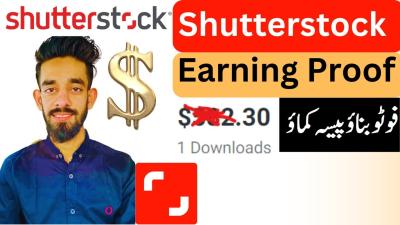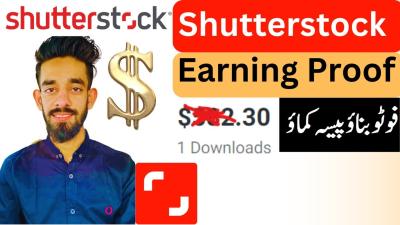Thinking about turning your photography hobby into a source of income? Shutterstock is one of the biggest platforms where photographers and creators share their work and earn money. But how much can you actually make? If you’re curious about the potential earnings from Shutterstock stock photos, you’re in the right place! In this post, we’ll explore how
Factors Influencing Shutterstock Payout Rates

When it comes to earning money from Shutterstock, several factors come into play that can influence how much you get paid per download. Let’s break down the main elements that impact your payout rates:
- Contributor Level: Shutterstock has a tiered contributor program that rewards consistent contributors with higher earnings. As you submit more approved images and generate more downloads, you can advance from a Basic to an Elite contributor, which increases your payout percentage.
- Image Type and Subscription Model: Shutterstock offers different licensing options—primarily subscription plans and on-demand purchases. Typically, downloads via subscriptions pay less per image but tend to be higher in volume, while single-image purchases pay more per download. Your payout rate varies depending on the license type.
- Royalty Rate Structure: Shutterstock uses a royalty system based on your contributor level and the total number of downloads. New contributors start with a base rate, which increases as you reach milestones. The platform also offers a bonus system for high-performing images.
- Image Quality and Relevance: High-quality, relevant images tend to get more downloads, increasing your earning potential. Shutterstock’s algorithm favors well-tagged, clear, and appealing images, so investing time in quality and keywording can pay off.
- Exclusive vs. Non-Exclusive Content: If you choose to be exclusive with Shutterstock, you might enjoy higher royalty rates. Conversely, non-exclusive images can be sold on multiple platforms, which might reduce your earnings per image but offer broader exposure.
Understanding these factors helps you strategize your contributions effectively. Focus on creating high-quality, relevant images, and keep an eye on your contributor level to maximize your payout rates. Remember, consistency is key—you’ll see better earnings as you build your portfolio and reputation on the platform.
How Shutterstock Determines the Payout Amount for Contributors

One of the most common questions new contributors have is, “How exactly does Shutterstock decide how much I’ll earn from my photos?” The answer isn’t a simple flat rate; instead, it’s a mix of several factors that work together to calculate your payout. Let’s break it down so you can get a clearer picture.
First off, Shutterstock uses a tiered royalty system based on your lifetime earnings and the type of license purchased. When you start, you’re in the Standard Contributor Royalties tier, earning around 20-30% of the sale price per download. As your portfolio grows and you reach specific earning milestones, you can move into higher tiers that pay more per download, sometimes up to 40% or more.
The main factors influencing your payout include:
- Type of License: Shutterstock offers Standard and Enhanced licenses. Standard licenses are cheaper and more common, providing lower royalties, while Enhanced licenses are more expensive, offering higher payouts.
- Customer Type: Royalty rates are generally the same regardless of whether a customer is an individual or a business, but the total number of downloads and licenses you sell affect your overall earnings.
- Contributor Level: As you contribute more and your earnings increase, you advance through different contributor levels, unlocking higher percentage rates.
- Subscription vs. On-Demand Downloads: Shutterstock offers both subscription plans and pay-per-download options. Downloads through subscriptions tend to generate lower royalties per download, but they can add up over time if you have a large volume.
Moreover, Shutterstock periodically adjusts its payout structure. They might introduce new tiers or modify the percentage rates. Staying active and uploading quality content increases your chances of moving up tiers, which directly boosts your potential earnings per download.
In essence, your payout depends on a combination of your contributor level, the license type, and the volume of downloads. The more high-value licenses you sell and the higher tier you’re in, the more you stand to earn per download. Keep contributing consistently, improve your content quality, and keep an eye on Shutterstock’s updates to maximize your income potential!
Average Earnings per Stock Photo Download
Now, let’s talk about what you can realistically expect to earn per download on Shutterstock. The truth is, it varies quite a bit based on several factors, but having some averages can help you set realistic expectations.
Typically, the average earnings per download for contributors fall within the range of $0.25 to $2.50. Here’s a quick breakdown:
| License Type | Average Earnings per Download |
|---|---|
| Standard License | $0.25 – $1.00 |
| Enhanced License | $10.00 – $25.00 |
As you can see, most of your downloads will be under the Standard license, which pays a smaller amount per download. However, if your images are of high quality and in demand for commercial projects, they might get licensed under Enhanced licenses, leading to much higher earnings.
It’s also important to remember that your overall earnings are influenced by the volume of downloads. For example, if you upload 100 images and each gets 10 downloads under Standard licenses, you might earn anywhere from $25 to $100 for those images combined. On the other hand, a handful of images licensed for Enhanced use can significantly boost your total income.
Some top contributors report earning anywhere from a few dollars for small portfolios to thousands of dollars per month with large, high-quality collections. The key is consistent uploading, understanding what types of images sell best, and optimizing your keywords to attract buyers.
In summary, while the average earnings per download might seem modest, the real earning potential lies in volume, licensing type, and the quality of your content. Keep creating, experimenting, and learning what works best — and over time, you’ll see your earnings grow!
Tips to Maximize Your Earnings on Shutterstock
Thinking about boosting your income as a Shutterstock contributor? You’re in the right place! While earning from stock photography can be rewarding, it’s also a game of strategy. Here are some practical tips to help you maximize your earnings and stand out in the crowded marketplace.
Focus on High-Demand Niches
Research trending topics and popular categories on Shutterstock. Think about evergreen themes like business, technology, health, or lifestyle, which tend to attract consistent downloads. Keep an eye on current events or seasonal trends—images related to holidays or recent developments often see a spike in demand.
Create Quality Over Quantity
While uploading frequently is good, prioritizing quality is even better. Use high-resolution images with good lighting, clear composition, and minimal noise. Well-edited photos that look professional tend to get more downloads and higher payouts.
Optimize Your Keywords and Titles
Effective keywording makes your images more discoverable. Use descriptive, relevant keywords that potential buyers might search for. Don’t stuff keywords—be specific and accurate. Clear titles that mention the subject and context of your photo also help improve visibility.
Consistent Uploads and Portfolio Diversity
Maintain a steady flow of new content. A diverse portfolio covering various subjects and styles can attract different buyers, increasing your overall earnings. Keep analyzing which images perform best and create similar content to capitalize on those trends.
Engage with Shutterstock Community and Resources
Join forums, webinars, or tutorials offered by Shutterstock or other photographers. Learning from others’ experiences and staying updated on platform policies can give you an edge. Plus, engaging with the community can inspire new ideas and improve your skills.
Utilize Promotions and Special Opportunities
Sometimes Shutterstock runs promotions or special campaigns. Participating in these can boost your visibility and sales. Keep an eye out for such opportunities and be ready to contribute relevant content.
Comparison of Shutterstock Payouts with Other Stock Photo Platforms
When it comes to earning from stock photography, it’s essential to compare how Shutterstock stacks up against other platforms. Each site has its own payout structure, audience, and benefits. Let’s take a quick look at how Shutterstock compares to some of the major players in the industry.
Shutterstock
- Payout Rate: Varies based on your contributor level and download type, typically between 15% and 40% of the price.
- Revenue Model: Revenue share per download, with higher earnings possible through subscriptions and extended licenses.
- Additional Benefits: Large global customer base, regular promotional opportunities, and a straightforward contributor dashboard.
Adobe Stock
- Payout Rate: 33% of the sale price, which is straightforward and predictable.
- Revenue Model: Flat percentage, with potential for higher earnings if you are exclusive with Adobe Stock.
- Additional Benefits: Integration with Adobe Creative Cloud apps, making it easy for designers to access your images.
Getty Images/iStock
- Payout Rate: Ranges from 15% to 45%, depending on exclusivity and image sales volume.
- Revenue Model: Tiered, with higher rates for exclusive contributors.
- Additional Benefits: Premium clientele and high-profile licensing opportunities, but higher standards for submissions.
Alamy
- Payout Rate: About 40% of the sale price, often one of the highest in the industry.
- Revenue Model: Flat percentage, with no exclusivity requirement.
- Additional Benefits: Larger commission and fewer restrictions on licensing and image use.
Summary Table
| Platform | Payout Rate | Key Benefits |
|---|---|---|
| Shutterstock | 15-40% | Large customer base, promotional opportunities |
| Adobe Stock | 33% | Integration with Adobe Creative Cloud |
| Getty/iStock | 15-45% | High-end clients, licensing options |
| Alamy | 40% | High commission, flexible licensing |
So, which platform is best for maximizing your earnings? It depends on your goals, style, and whether you prefer broad exposure or high-paying niche markets. Many successful contributors upload to multiple sites, diversifying income streams and taking advantage of each platform’s strengths. Happy shooting—and may your images bring in those earnings!
Conclusion and Final Thoughts on Shutterstock Photo Income Potential
Understanding Shutterstock’s payout system is essential for photographers aiming to maximize their earnings. While the actual income varies based on factors such as image quality, niche, and licensing type, consistent quality and strategic portfolio management can significantly boost your revenue. Top contributors often earn a substantial passive income, with some making thousands of dollars per month, but for most, earnings tend to grow gradually over time.
It’s important to recognize that Shutterstock offers multiple earning streams, including:
- Standard licenses: Suitable for most commercial uses, providing a steady income per download.
- Enhanced licenses: Higher payouts due to increased usage rights.
- Exclusive contributions: Potentially higher royalties but requiring exclusivity.
Success on Shutterstock depends on consistency, understanding market demand, and continuously updating your portfolio. While there is no guaranteed income, many contributors find Shutterstock a viable platform for earning passive income over time. Remember, patience and quality are key to unlocking your full earning potential.
In summary, with dedication and strategic contributions, Shutterstock can be a valuable source of income for photographers and artists alike, turning your creativity into a profitable venture.


